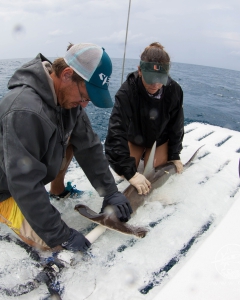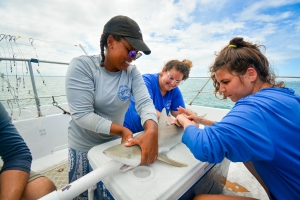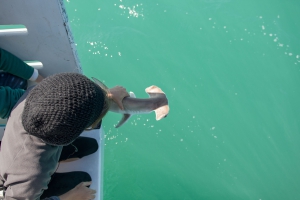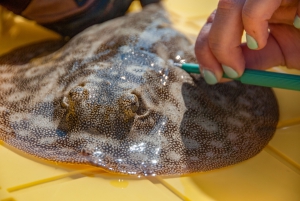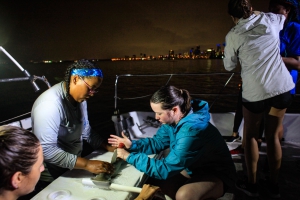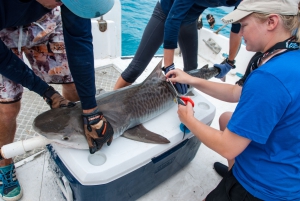Overview
Some species of shark rely on specific habitats for gestation (pregnancy), parturition (giving birth), or in their early years of life. These nurseries can represent critical habitat that species rely on, and in some cases sharks return to the same area where they were born to give birth. Protecting nursery habitats can be an important part of conserving shark species. Scientists determine an area is a shark nursery by looking at three key factors (drawn from Heupel et al. 2007): whether juvenile sharks are more common within than outside the possible nursery area, whether they spend significant periods within the nursery, and whether the area remains in use by juveniles across multiple years.
The SRC team studies shark reproduction: everything from the hormonal processes that prepare sharks for mating and pregnancy to ultrasounds of gestating embryos to collecting data from the newborn sharks in Biscayne Bay each year. We are working to identify key habitats and understand how human changes to these ecosystems might alter the health and growth of young sharks.
Our Research on the Big Screen
Discovery’s Shark Week – First Ever Tiger Shark Sonogram Reveals Pups
McClain MA, Hammerschlag N, Gallagher AJ, Drymon JM, Grubbs RD, Guttridge TL, Smukall MJ, Frazier BS, Daly-Engel TS (2022) Age-Dependent Dispersal and Relatedness in Tiger Sharks (Galeocerdo cuvier). Front. Mar. Sci. 9:900107. doi: 10.3389/fmars.2022.900107
Jacoby DM, Fairbairn BS, Frazier BS, Gallagher AJ, Heithaus MR, Cooke SJ, Hammerschlag N. (2021) Social network analysis reveals the subtle impacts of tourist provisioning on the social behaviour of a generalist marine apex predator. Frontiers in Marine Science, 1202. https://doi.org/10.3389/fmars.2021.665726
Rangel BS, Hammerschlag N, Sulikowski JA, Moreira RG (2021) Dietary and reproductive biomarkers in a generalist apex predator reveal differences in nutritional ecology across life stages. Marine Ecology Progress Series 664:149-163. https://doi.org/10.3354/meps13640
Morgan A, Calich C, Sulikowski J, Hammerschlag N. (2020) Evaluating spatial management options for tiger shark (Galeocerdo cuvier) conservation in US Atlantic Waters. ICES Journal of Marine Science, fsaa193, https://doi.org/10.1093/icesjms/fsaa193
Hammerschlag N, Skubel RA, Sulikowski J, Irschick DJ, Gallagher AJ. (2018). A Comparison of Reproductive and Energetic States in a Marine Apex Predator (the Tiger Shark, Galeocerdo cuvier). Physiological and Biochemical Zoology 2018 91:4, 933-942
Hammerschlag N, Gutowsky LFG, Gallagher AJ, Matich P, Cooke SJ. (2017). Diel habitat use patterns of a marine apex predator (tiger shark, Galeocerdo cuvier) at a high use area exposed to dive tourism. Journal of Experimental Marine Biology and Ecology, 495: 24-34.
Sulikowski J, Wheeler CR, Gallagher AJ, Prohaska BK, Langan JA, Hammerschlag N. (2016). Seasonal and life-stage variation in the reproductive ecology of a marine apex predator, the tiger shark Galeocerdo cuvier, at a protected female dominated site. Aquatic Biology, 24: 175-184
Hammerschlag N, Broderick AC, Coker JW, Coyne MS, Dodd M, Frick MG, Godfrey MH, Godley BJ, Griffin DB, Hartog K, Murphy SR, Murphy TM, Nelson ER, Williams KL, Witt MJ, Hawkes LA (2015). Evaluating the landscape of fear between apex predatory sharks and mobile sea turtles across a large dynamic seascape. Ecology, 96(8): 2117-2126.
Irschick, DJ, Hammerschlag N, (2014). Morphological scaling of body form in four shark species differing in ecology and life-history. Biological Journal of the Linnean Society
Irschick DI., Hammerschlag N. (2014). A new metric for measuring condition in large predatory sharks. Journal of Fish Biology; 85(3), 917-926.
Gallagher, AJ, Wagner, DN, Irschick, DJ, Hammerschlag N. (2014).Body condition predicts energy stores in apex predatory sharks. Conservation Physiology:2 DOI: 10.1093/conphys/cou022
Hammerschlag N, Gallagher AJ, Carlson JK. (2013). A revised estimate of daily ration in the tiger shark (Galeocerdo cuvier) with implications for assessing ecosystem impacts of apex predators. Functional Ecology, 27 (5): 1273-1274
Hammerschlag N, Gallagher AJ, Wester J, Luo J, Ault JS. (2012)(Cover) Don’t bite the hand that feeds: assessing ecological impacts of provisioning ecotourism on an apex marine predator. Functional Ecology, 26(3): 567-576
Hammerschlag N, Sulikowski J. 2011. Killing for Conservation: The Need for Alternatives to Lethal Sampling of Apex Predatory Sharks. Endangered Species Research 14: 135–140

